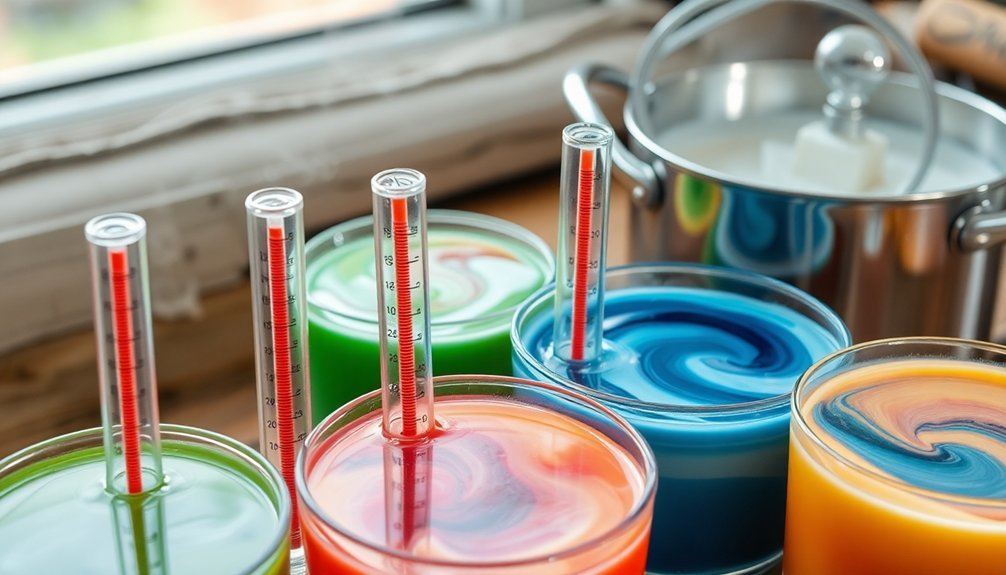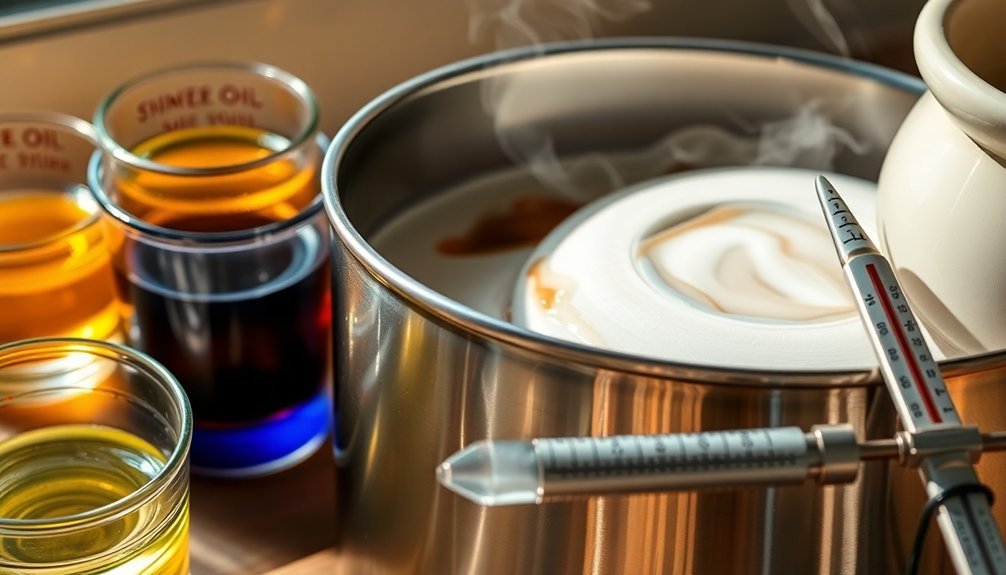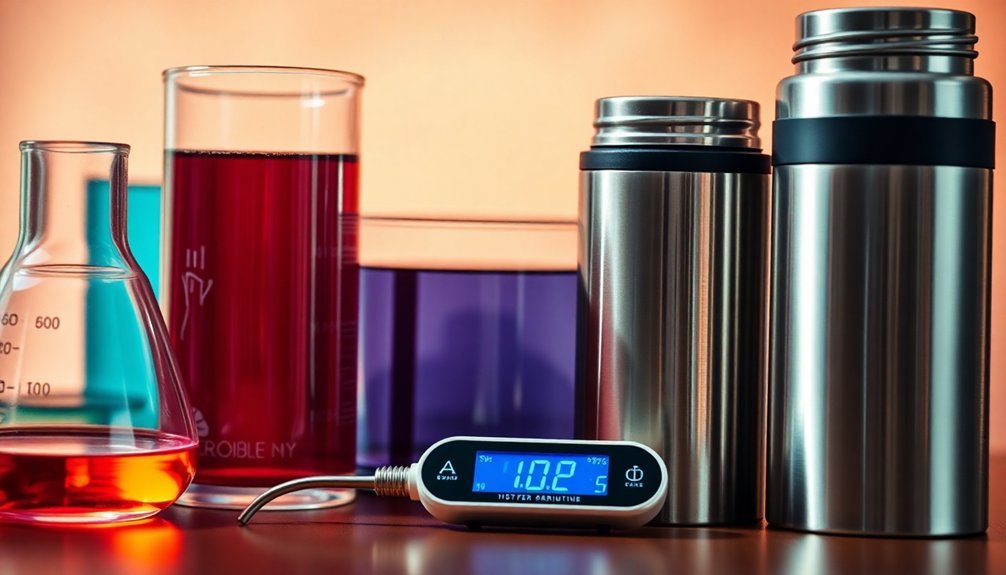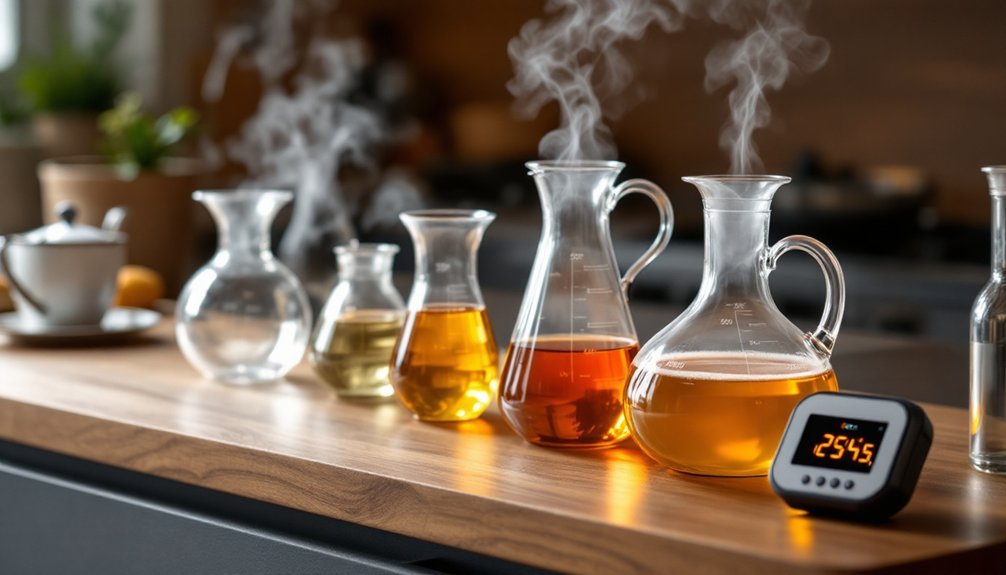Stainless steel vessels maintain the most consistent temperatures for soap making, with superior heat retention for proper saponification. They're ideal for maintaining temperatures between 38-50°C and require less energy for temperature stability. Ceramic vessels with insulation offer excellent stability for cold process methods, while glass works well for complex patterns at 29-35°C. Your vessel choice directly impacts soap quality, color vibrancy, and texture—factors that can make or break your final product.
Critical Temperature Stages in Traditional Soap Making

While many crafters focus on ingredients and design techniques, temperature control actually forms the backbone of successful soap making. Your initial mix temperature—typically between 80°F and 120°F—determines how quickly saponification begins and affects your working time with the soap batter.
As your oils and lye combine, the exothermic reaction generates heat, pushing your batch through distinct stages. First comes emulsification, then trace, and finally the vital gel phase. For medium-water recipes, gel phase initiates around 160°F, though this varies with lye concentration.
You'll need to adjust your approach based on your oils' melting points and additives. Milk soaps require lower temperatures to prevent scorching, while certain fragrances can literally evaporate if your batch runs too hot. Recording temperature profiles can help diagnose ingredient issues and improve your soap quality through consistent documentation.
Comparing Stainless Steel vs. Wooden Soap Vessels for Heat Retention
When choosing between soap vessels, you'll find stainless steel offers superior heat capacity, retaining temperature far longer than wooden alternatives during critical soap-making phases.
This prolonged thermal gradient stability in steel vessels means your soap batches maintain consistent temperatures throughout the saponification process, reducing the need for frequent reheating. Utilizing a double jacketed tank provides even more efficient heat distribution and prevents burnt oils, ensuring consistently high-quality products.
You'll notice this difference most dramatically during winter production, when wooden vessels can lose heat rapidly, potentially compromising batch quality and increasing energy costs.
Material Heat Capacity Comparison
Despite their common use in soap making, stainless steel and wooden vessels differ dramatically in their heat capacity properties. Stainless steel's superior thermal conductivity (12.4 W/m-K) allows for rapid heat transfer and uniform temperature maintenance, while wooden vessels lag considerably with only 0.15-0.25 W/m-K.
| Property | Stainless Steel | Wooden Vessels |
|---|---|---|
| Thermal Conductivity | 12.4 W/m-K | 0.15-0.25 W/m-K |
| Heat Retention | Superior | Requires insulation |
| Energy Efficiency | High with jacketed designs | Lower, needs more energy |
| Temperature Stability | Maintains consistency | Fluctuates more readily |
| Long-term Performance | Maintains properties | Degrades with use |
You'll find stainless steel requires less energy to maintain consistent temperatures, offering cost savings despite higher initial investment. Professional equipment like SoapMelters' double-walled design contributes to virtually 100% energy efficiency while preventing hot spots. Wooden vessels need additional insulation methods to achieve comparable stability.
Thermal Gradient Longevity
The thermal gradient longevity between stainless steel and wooden vessels creates significant differences in soap quality and production efficiency.
Stainless steel maintains temperature stability throughout the saponification process, enhancing your soap's hardness and longevity without additional insulation.
Wooden vessels, while aesthetically pleasing, require extra insulation to achieve similar thermal consistency. Their natural properties cause more temperature fluctuations that can affect your soap's final quality. When properly insulated, however, they can still yield excellent results.
Your environmental conditions matter too—high humidity prolongs curing time regardless of vessel choice. Proper moisture management during curing allows excess water to evaporate, significantly improving the soap's durability over time.
For best results, match your vessel to your workspace: use stainless steel in variable environments, and wooden molds with proper insulation in temperature-controlled spaces.
This approach guarantees your soap develops the ideal hardness and longevity through consistent thermal conditions.
Achieving Ideal Saponification Temperatures in Various Vessel Types

Most successful soap makers understand that maintaining proper temperature control represents one of the most critical factors in achieving consistent saponification results. Your vessel choice greatly impacts how well you'll maintain the ideal 27°C-50°C range during processing. Selecting appropriate containers is especially important when working with coconut oil, as it saponifies quickly and requires careful temperature management.
| Vessel Type | Temperature Stability | Best For |
|---|---|---|
| Stainless Steel | Excellent conductivity | Higher temp (38-50°C) recipes |
| Glass | Moderate retention | Complex patterns (29-35°C) |
| Insulated Ceramic | Superior heat retention | Cold process methods |
When working with specialty ingredients like beeswax (melting point ~63°C), you'll need vessels that can maintain higher temperatures without fluctuation. Remember that vessel size matters too—larger batches retain heat longer, while smaller ones cool quickly, potentially affecting your trace time and final product consistency.
Monitoring and Maintaining Temperature Stability During Curing
To maintain consistent quality in your batch curing process, you'll need reliable temperature monitoring systems that provide real-time feedback on your materials' conditions.
You can control exothermic reactions by implementing sensors that alert you to temperature spikes before they compromise product integrity.
Specialized vessels with uniform heating elements distribute warmth evenly throughout your batch, preventing cold spots that could lead to inconsistent curing rates and potential product defects.
Adding precise relative humidity control alongside temperature regulation is essential for optimal curing of adhesives like polyvinyl acetate-based glues and silicone sealants.
Temperature Monitoring Techniques
Effective temperature monitoring lies at the heart of successful curing processes, requiring specialized techniques to guarantee stability throughout the entire curing cycle.
You'll need thermocouples for precise measurements and infrared thermometers for quick surface readings without disturbing your materials.
For thorough temperature analysis, consider thermal imaging cameras that visualize heat distribution across your entire batch. Wireless sensors embedded within your materials provide real-time data, while data loggers track temperature variations over extended periods. Proper monitoring helps prevent concrete from freezing or overheating, which can significantly impact its final strength and durability.
Advanced options include fiber-optic sensors for monitoring composites, dielectric sensors to measure material property changes, and ultrasonic technology to detect subtle shifts during curing.
Remember that proper sensor placement is essential—strategically position your monitoring equipment to capture readings from different depths, ensuring your entire batch maintains ideal temperature conditions according to ASTM standards.
Exothermic Reaction Control
Controlling exothermic reactions during the curing process represents one of the most critical challenges in batch stability management. You'll need strategic approaches to prevent material damage and guarantee uniform curing.
Consider using specialized temperature vessels with high-density fillers that act as heat sinks, distributing heat evenly throughout your batch. When working with epoxies or methacrylates, reduce batch sizes to minimize total heat generation.
For larger volumes, implement cooling techniques like water baths or forced air systems. Uncontrolled exotherms can cause epoxy to solidify in about 5 minutes when using large batches.
Don't overlook material selection—choose resins formulated specifically for low exotherm properties. Adding thermal management materials can prevent hotspots, while maintaining a cool working environment helps control the overall reaction rate.
Remember that proper exotherm management isn't just about quality—it's also critical for safety, preventing fire hazards and structural defects.
Uniform Heating Solutions
Uniform heat distribution represents the next challenge in maintaining batch stability after managing exothermic reactions.
You'll need systems that provide consistent temperature throughout your entire batch to guarantee quality outcomes.
Industrial ovens with precise temperature control and uniform airflow offer a reliable solution for consistent curing conditions.
For thermoset plastic and rubber molding, consider Isobar heat pipes that deliver near-isothermal conditions while enhancing mold face temperature recovery.
The ThermalCure system utilizes radiant heat through finned pipes to accelerate concrete curing at controlled temperatures up to 68°C.
For epoxy applications, Powerblanket heaters provide uniform heat up to 180°F with proprietary heat-spreading technology that prevents overheating.
Each solution allows for independent temperature control of multiple molds, maintaining your production efficiency while guaranteeing product quality.
Kitchen ovens should be avoided as they can lead to serious accidents due to uneven heating or material melting during the curing process.
How Vessel Insulation Affects Cold Process Soap Quality
The quality of your cold process soap depends greatly on how well you insulate your vessels during the curing process. Proper insulation maintains ideal temperatures, promoting complete saponification and enhancing your soap's appearance.
Masterful insulation ensures your cold process soap reaches peak quality by maintaining perfect temperatures throughout saponification.
In cold environments, you'll need additional insulation to prevent slow hardening, while warm climates might require minimal coverage. Spicy fragrance oils can naturally increase temperature during saponification, requiring you to adjust your insulation approach accordingly.
Your choice of vessel notably impacts insulation efficiency. Large loaf molds retain heat better than individual cavity molds, and different materials conduct heat differently, affecting your insulation strategy.
For best cold process soap results:
- Match insulation to your environment – use more in cold rooms, less in warm spaces
- Consider your vessel type when planning insulation
- Aim for gel phase (up to 180°F) for vibrant colors and glossy finish
- Monitor temperature to prevent issues like alien brain texture or soda ash
Selecting Temperature-Responsive Vessels for Different Soap Formulations

Beyond proper insulation, your selection of temperature-responsive vessels plays a significant role in creating successful soap formulations.
When working with beeswax-based recipes, opt for vessels that maintain higher temperatures (around 65°C) to prevent premature hardening.
For milk soaps, choose insulated containers that keep temperatures cooler (100-110°F) to avoid scorching delicate ingredients.
If you're creating swirl designs, select vessels offering temperature stability to prevent acceleration that disrupts your patterns.
Consider your climate, too. In warmer environments, you'll need vessels that cool mixtures efficiently, while cold climates require better insulation. When soaping in hot weather, maintain your work area at a reasonable temperature to prevent your oils from separating due to warmer weather conditions.
High-oil formulas benefit from slow-cooling vessels to prevent separation issues.
Digital thermometers are essential companions to any vessel choice, helping you monitor temperatures precisely throughout the process, regardless of which container you select.
Frequently Asked Questions
Can Recycled Materials Be Used for Temperature-Controlled Soap Vessels?
Yes, you can use recycled aluminum and steel for temperature-controlled soap vessels. They're 100% recyclable, maintain precise temperatures efficiently, and help you reduce environmental impact while ensuring consistent product quality in your soap production.
How Do Electromagnetic Fields Affect Temperature Stability in Metallic Vessels?
Electromagnetic fields can disrupt your metallic vessel's temperature stability by inducing eddy currents, causing uneven heating. They'll also potentially interfere with electronic control systems and alter heat transfer patterns within your vessel walls.
What Temperature Fluctuations Occur at Different Batch Scaling Ratios?
At smaller batch scales, you'll notice greater temperature fluctuations due to higher surface-to-volume ratios. Your larger batches maintain steadier temperatures naturally, though they face challenges with uniform heat distribution throughout the entire volume.
Are Ceramic Vessels Viable for Precise Temperature Control in Soap Making?
No, ceramic vessels aren't viable for precise temperature control in soap making. They react with lye, distribute heat unevenly, and cool too slowly. You'll achieve better results using stainless steel or specialized soap making equipment.
How Does Ambient Humidity Impact Vessel Temperature Maintenance Requirements?
Higher ambient humidity increases your vessel's temperature maintenance needs. You'll need better insulation and dehumidification systems to prevent condensation, which can cause temperature fluctuations and compromise your temperature control accuracy.
In Summary
Choosing the right vessel for your soap making isn't just about material—it's about temperature control. You'll find stainless steel offers precision while wooden vessels provide natural insulation. When you're monitoring your batch, remember that consistent temperatures during saponification directly impact your final product's quality. Whether you're crafting cold process or hot process soaps, your vessel's thermal properties will determine your success. Match your container to your technique!





Leave a Reply